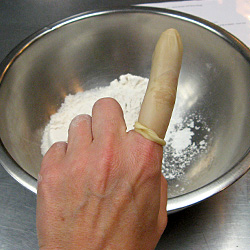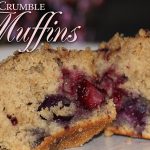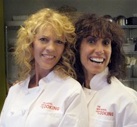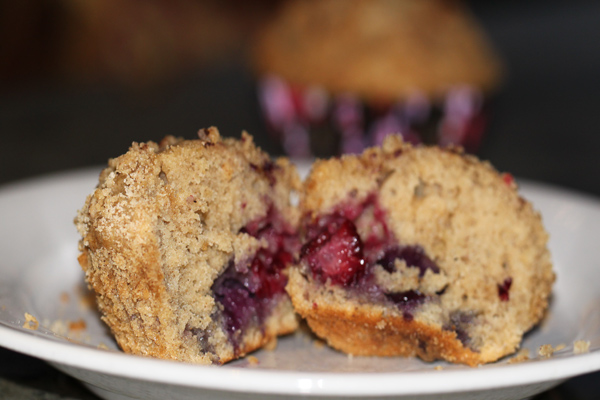Methods & Madness… Class 17: Quick Breads
Recipes & Ramblings from Chef School
After working with yeast last week, we sped up our baking lesson this week with quick breads. I love that you don’t need to be a great baker to achieve success in the kitchen.
 What I didn’t anticipate was how dangerous moving too quickly in the kitchen can be (not to mention using a chef’s knife to cut butter – dumb, dumb, dumb!) And that is how I almost got benched this week, were it not for an unusual product called “finger cots” (which tickles my inner adolescent-boy funny bone). These digit prophylactics are used in professional kitchens to cover boo-boos, and prevent Band-Aids and associated “things” from becoming part of the recipe.
What I didn’t anticipate was how dangerous moving too quickly in the kitchen can be (not to mention using a chef’s knife to cut butter – dumb, dumb, dumb!) And that is how I almost got benched this week, were it not for an unusual product called “finger cots” (which tickles my inner adolescent-boy funny bone). These digit prophylactics are used in professional kitchens to cover boo-boos, and prevent Band-Aids and associated “things” from becoming part of the recipe.
You can buy finger cots at your local drug store or online.
The Quick and the Bread
“Quick bread” refers to any bread that uses leaveners like baking powder or baking soda instead of yeast, and requires no kneading or rising time.
These breads cover a wide variety from scones and biscuits (made from dough) to muffins and loaves (made from batter). They can be savory or sweet
The Basics
You need five basic ingredients for a quick bread – flour, leavening (baking powder, baking soda), fat (butter, shortening or oil), eggs and milk (or some other liquid). What you add beyond these ingredients is a matter of preference. Think of it as a master recipe.
 Baking soda is bicarbonate of soda. It is alkaline, and when combined with an acid, it creates carbon dioxide bubbles, giving rise to doughs and batters. Baking soda alone is normally used when buttermilk, yogurt, chocolate, honey or other acidic liquid is used in the recipe.
Baking soda is bicarbonate of soda. It is alkaline, and when combined with an acid, it creates carbon dioxide bubbles, giving rise to doughs and batters. Baking soda alone is normally used when buttermilk, yogurt, chocolate, honey or other acidic liquid is used in the recipe.
 Baking powder is a combination of baking soda, cream of tartar, and cornstarch. It causes baked goods to rise by releasing bubbles of carbon dioxide gas into a batter. It is double acting, meaning that it acts once when moisture is added, and again when heat is applied.
Baking powder is a combination of baking soda, cream of tartar, and cornstarch. It causes baked goods to rise by releasing bubbles of carbon dioxide gas into a batter. It is double acting, meaning that it acts once when moisture is added, and again when heat is applied.
TIPS
Baking powder and baking soda does lose its potency over time. Here is how to test it before using in a recipe.
- Baking powder: mix 1 tsp. baking powder with 1/2 cup hot water. Mixture should fizz instantly.
- Baking soda: mix 1/4 tsp. baking soda with 2 tsp. of vinegar or lemon juice. Mixture should fizz instantly.
Mix It Up
One of the secrets to moist quick bread is mixing just enough to combine ingredients. Over-mixing will cause holes where the air bubbles escaped, and will make the bread tough. There are three basic mixing methods.
- The blending method – (aka the muffin method, the stirring method, or the quick-bread method) Wet and dry ingredients are measured separately, mixed separately, and then quickly added together until just combined.
- The creaming method – this is the method used for cake batters. The butter and sugar are creamed together first, then eggs and flavorings added, followed by the dry ingredients and other liquid.
- The biscuit/shortening method – use this method for scones, biscuits and piecrusts. The ingredients used for this should be cold, especially the fat (butter, lard, shortening). The fat melts during baking and causes the baked goods to rise, adding flakiness. Overworking the dough will cause the fat to melt outside the oven, resulting in a tough finished product.
Measuring Up
It is important to measure ingredients accurately and use the right measuring cups.

Dry Measuring Cups
These cups are to be used with the “scoop and level” technique where the cup is filled to the top and then leveled off with a knife or other straight edge.
 Liquid Measuring Cups
Liquid Measuring Cups
These cups have a pour spout and are filled to the markers on the side of the cup (1/4 cup, 8 ounces, etc.) rather than being filled right up to the top.
Temperature Matters
Another secret to successful baking is making sure your ingredients are at the temperature called for in the recipe. This allows for different interactions between your sugar, butter, flour, and water, which can make or break your recipe.
Click here to read a fascinating article on why temperatures are so important in baking. I think this will enhance your baking experience.
Class Assignment
Everyone had the chance to make a piecrust, which we then used for the base of quiche.


We choose our own ingredients and everybody came up with a different combination. I choose to sauté shallots, mushrooms, broccoli and goat cheese to cook in my quiche.


Rona shares a recipe for basic quiche as well as Quiche Lorraine on her blog, click here to view.
In addition to quiche, I made Berry Crumble Muffins with Jessica, my cooking partner for the evening. They are simple to make and freeze well.

Berry Crumble Muffins
Ingredients
Crumb Topping:
- ½ cup flour
- ½ cup brown sugar
- ½ teaspoon cinnamon
- ¼ teaspoon salt
- 2 ½ ounces cold unsalted butter 5 tablespoons
Muffin Batter:
- 2 cups flour
- ¼ cup sugar
- ¼ teaspoon nutmeg
- 1 teaspoon cinnamon
- ¼ teaspoon allspice
- ½ teaspoon salt
- 1 tablespoon baking powder
- ½ cup brown sugar
- 2 eggs
- 1/3 cup canola oil
- 2/3 cup milk
- 1 teaspoon vanilla extract
- 1 ½ cups blackberries blueberries or raspberries
Instructions
Crumb Topping
-
Mix together flour, brown sugar, cinnamon and salt. Cut in butter until the mixture looks crumbly. Refrigerate.
Muffin Batter:
-
Combine the flour, sugar, spices, baking powder and salt. Whisk until smooth.
-
In a separate bowl, whisk together the brown sugar, eggs, oil, milk and vanilla. Gently fold the dry ingredients into the wet. Add berries.
-
Spoon the batter evenly into lined, 12-cup muffin pan. (An ice cream scoop works great for this)
-
Top with crumb mixture.
-
Bake at 350 degrees for 25 minutes or until a toothpick comes out clean.
Recipe Notes
Cook time: 25mins
Serves: 6
Fun Facts
Three states in the U.S. have adopted muffins as their official state food.
- Minnesota – Blueberry Muffin
- Massachusetts – Corn Muffin
- New York – Apple Muffin
I wonder what state is brave enough to adopt the Fruits and Nuts Muffin?
…and then she paused for thought.

Hope you have enjoyed our adventure in the culinary classroom. Join us each week as we continue learning new culinary skills.
You can also read about Rona’s experience on her blog or What’s Cookin online magazine.
Yum

I never would have thought that honey is an acidic liquid! But I studied languages and literature, happily leaving organic chemistry to the other kids:) I would have regretted not taking more classes, but I am glad I can learn in a different way, through you (and Alton Brown – love the guy and his approach to cooking:)
I need to get me some finger cots pretty soon, as I always cut myself (most of the time while rushing and using a dull knife – abomination, I know:)
I love quiches and make them fairly often with a soup as the first course. Your combination of flavors really appeals to me (and it looks delicious, too:)
Looking forward to seeing you soon! I hope your finger gets better:)
Thanks Lana!
For as many times I have cut myself in the kitchen learning about finger cots was priceless.
Awesome overview of the distinctions between baking soda and baking powder (that has always confused me!) and LOVE your tips on quick checks for potency PLUS the side article on temperatures was great reading too! I’m attempting to permanently lock this info in my brain. 🙂
Thanks Leslie!
I am attempting to lock all the information in my brain as well. The next two weeks of cooking school is all testing. This is where we get to see what we really learned!
I’m jealous that your class was able to pick any filling for you quiche… we made the quiche assembly-line style, each making our own crust and then filling with either bacon and onions or asparagus.
My favorite recipe of the day were the muffins… not too sweet and perfectly fluffy.
Hi Deena,
We all made the same crust as well and they all looked so different! As far as ingredients, nobody choose the same thing. They were all quite tasty. I have made the muffins twice now as they are so good.